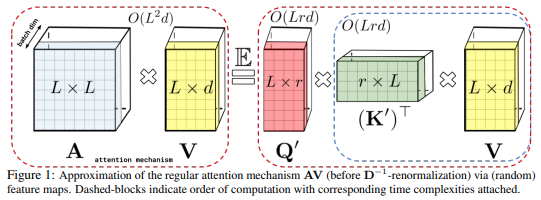lucidrains / Performer Pytorch
Programming Languages
Projects that are alternatives of or similar to Performer Pytorch
Performer - Pytorch
An implementation of Performer, a linear attention-based transformer variant with a Fast Attention Via positive Orthogonal Random features approach (FAVOR+).
Install
$ pip install performer-pytorch
Usage
Performer Language Model
import torch
from performer_pytorch import PerformerLM
model = PerformerLM(
num_tokens = 20000,
max_seq_len = 2048, # max sequence length
dim = 512, # dimension
depth = 12, # layers
heads = 8, # heads
causal = False, # auto-regressive or not
nb_features = 256, # number of random features, if not set, will default to (d * log(d)), where d is the dimension of each head
feature_redraw_interval = 1000, # how frequently to redraw the projection matrix, the more frequent, the slower the training
generalized_attention = False, # defaults to softmax approximation, but can be set to True for generalized attention
kernel_fn = nn.ReLU(), # the kernel function to be used, if generalized attention is turned on, defaults to Relu
reversible = True, # reversible layers, from Reformer paper
ff_chunks = 10, # chunk feedforward layer, from Reformer paper
use_scalenorm = False, # use scale norm, from 'Transformers without Tears' paper
use_rezero = False, # use rezero, from 'Rezero is all you need' paper
tie_embedding = False, # multiply final embeddings with token weights for logits, like gpt decoder
ff_glu = True, # use GLU variant for feedforward
emb_dropout = 0.1, # embedding dropout
ff_dropout = 0.1, # feedforward dropout
attn_dropout = 0.1, # post-attn dropout
local_attn_heads = 4, # 4 heads are local attention, 4 others are global performers
local_window_size = 256 # window size of local attention
)
x = torch.randint(0, 20000, (1, 2048))
mask = torch.ones_like(x).bool()
model(x, mask = mask) # (1, 2048, 20000)
Plain Performer, if you are working with say images or other modalities
import torch
from performer_pytorch import Performer
model = Performer(
dim = 512,
depth = 1,
heads = 8,
causal = True
)
x = torch.randn(1, 2048, 512)
model(x) # (1, 2048, 512)
Encoder / Decoder - Made possible by Thomas Melistas
import torch
from performer_pytorch import PerformerEncDec
SRC_SEQ_LEN = 4096
TGT_SEQ_LEN = 4096
GENERATE_LEN = 512
enc_dec = PerformerEncDec(
dim = 512,
tie_token_embed = True,
enc_num_tokens = 20000,
enc_depth = 6,
enc_heads = 8,
enc_max_seq_len = SRC_SEQ_LEN,
dec_num_tokens = 20000,
dec_depth = 6,
dec_heads = 8,
dec_max_seq_len = TGT_SEQ_LEN,
)
src = torch.randint(0, 20000, (1, SRC_SEQ_LEN))
tgt = torch.randint(0, 20000, (1, TGT_SEQ_LEN))
src_mask = torch.ones_like(src).bool()
tgt_mask = torch.ones_like(src).bool()
# train
enc_dec.train()
loss = enc_dec(src, tgt, enc_mask = src_mask, dec_mask = tgt_mask)
loss.backward()
# generate
generate_in = torch.randint(0, 20000, (1, SRC_SEQ_LEN)).long()
generate_out_prime = torch.tensor([[0.]]).long() # prime with <bos> token
samples = enc_dec.generate(generate_in, generate_out_prime, seq_len = GENERATE_LEN, eos_token = 1) # assume 1 is id of stop token
print(samples.shape) # (1, <= GENERATE_LEN) decode the tokens
Standalone self-attention layer with linear complexity in respect to sequence length, for replacing trained full-attention transformer self-attention layers.
import torch
from performer_pytorch import SelfAttention
attn = SelfAttention(
dim = 512,
heads = 8,
causal = False,
).cuda()
x = torch.randn(1, 1024, 512).cuda()
attn(x) # (1, 1024, 512)
To minimize model surgery, you could also simply rewrite the code, so that the attention step is done by the FastAttention module, as follows.
import torch
from performer_pytorch import FastAttention
# queries / keys / values with heads already split and transposed to first dimension
# 8 heads, dimension of head is 64, sequence length of 512
q = torch.randn(1, 8, 512, 64)
k = torch.randn(1, 8, 512, 64)
v = torch.randn(1, 8, 512, 64)
attn_fn = FastAttention(
dim_heads = 64,
nb_features = 256,
causal = False
)
out = attn_fn(q, k, v) # (1, 8, 512, 64)
# now merge heads and combine outputs with Wo
Advanced
At the end of training, if you wish to fix the projection matrices to get the model to output deterministically, you can invoke the following
model.fix_projection_matrices_()
Now your model will have fixed projection matrices across all layers
Citations
@misc{choromanski2020rethinking,
title = {Rethinking Attention with Performers},
author = {Krzysztof Choromanski and Valerii Likhosherstov and David Dohan and Xingyou Song and Andreea Gane and Tamas Sarlos and Peter Hawkins and Jared Davis and Afroz Mohiuddin and Lukasz Kaiser and David Belanger and Lucy Colwell and Adrian Weller},
year = {2020},
eprint = {2009.14794},
archivePrefix = {arXiv},
primaryClass = {cs.LG}
}
@inproceedings{kitaev2020reformer,
title = {Reformer: The Efficient Transformer},
author = {Nikita Kitaev and Lukasz Kaiser and Anselm Levskaya},
booktitle = {International Conference on Learning Representations},
year = {2020},
url = {https://openreview.net/forum?id=rkgNKkHtvB}
}
@inproceedings{katharopoulos_et_al_2020,
author = {Katharopoulos, A. and Vyas, A. and Pappas, N. and Fleuret, F.},
title = {Transformers are RNNs: Fast Autoregressive Transformers with Linear Attention},
booktitle = {Proceedings of the International Conference on Machine Learning (ICML)},
year = {2020}
}
@misc{bachlechner2020rezero,
title = {ReZero is All You Need: Fast Convergence at Large Depth},
author = {Thomas Bachlechner and Bodhisattwa Prasad Majumder and Huanru Henry Mao and Garrison W. Cottrell and Julian McAuley},
year = {2020},
url = {https://arxiv.org/abs/2003.04887}
}
@article{1910.05895,
author = {Toan Q. Nguyen and Julian Salazar},
title = {Transformers without Tears: Improving the Normalization of Self-Attention},
year = {2019},
eprint = {arXiv:1910.05895},
doi = {10.5281/zenodo.3525484},
}
@misc{shazeer2020glu,
title = {GLU Variants Improve Transformer},
author = {Noam Shazeer},
year = {2020},
url = {https://arxiv.org/abs/2002.05202}
}
@misc{roy*2020efficient,
title = {Efficient Content-Based Sparse Attention with Routing Transformers},
author = {Aurko Roy* and Mohammad Taghi Saffar* and David Grangier and Ashish Vaswani},
year = {2020},
url = {https://arxiv.org/pdf/2003.05997.pdf}
}

